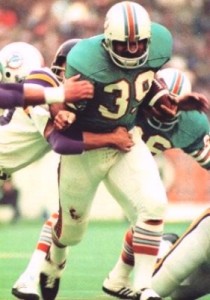Larry Csonka: The Zonk
The January Sports Then and Now Vintage Athlete of the Month was the leader of a running attack that was the cornerstone of two Super Bowl Championship teams, including the only undefeated squad in NFL history.
With his distinctive headgear and a body suited for punishing contact, Larry Csonka looked the part of a fullback and for 11 NFL seasons delivered and took regular punishment on his way to the Hall of Fame.
Following in the great tradition of Jim Brown, Ernie Davis, Jim Nance and Floyd Little, Csonka earned All-American honors at Syracuse while rushing for 2,934 yards. He began earning a name for himself as the Most Valuable Player of the East–West Shrine Game, the Hula Bowl, and the College All-Star Game.
Those honors helped him his draft stock and the Miami Dolphins chose him with the eighth pick of the 1968 combined AFL/NFL Draft.
The Dolphins, which had entered the AFL in the 1966 season, posted losing records during Csonka’s first two seasons and the fullback struggled with injuries and posted solid, but not spectacular, numbers with 540 yards as a rookie and 566 the following season.
In 1970 the dynamic quickly changed as Don Shula joined the Dolphins as head coach after a successful stint with the Baltimore Colts. Instantly, the Dolphins became a contender as they posted a 10-4 record in 1970 and reached the playoffs for the first time in team history.
Establishing the running game was the key to the Miami offense and Csonka responded with 874 yards and was named to the Pro Bowl for the first time.
The following season, Csonka eclipsed the 1,000-yard mark for the first time as he ranked first in the NFL in yards per carry (5.4 yards) and third in rushing yards (1,051) to earn Pro Bowl honors.
More importantly, the Dolphins took another step as a team in 1971 as they posted a 10-3-1 record and won the AFC East for the first time. In their playoff opener against the Kansas City Chiefs, Csonka rushed for 86 yards, including a key 29-yard run that helped lift Miami to overtime victory in the longest game in NFL history.
The Dolphins then defeated the Baltimore Colts before losing to the Dallas Cowboys in Super Bowl VI.
In 1972, Csonka rushed for a career-high 1,117 yards as the Dolphins led the NFL in rushing offense. Miami finished the season with a perfect 17-0 record, capped off by a 14-7 victory over the Washington Redskins in Super Bowl VII. Csonka gained 112 yards on just 15 carries to help lead the way to victory.
Csonka eclipsed the 1,000-yard mark for a third straight year in 1973 while earning first team All-Pro honors for the second time. The Dolphins finished with a 12-2 season record and became the first team to reach three consecutive Super Bowls.
Facing the Minnesota Vikings in Super Bowl VIII, Csonka was a one-man wrecking crew as he rushed for a then Super Bowl record 145 yards and two touchdowns.
Miami came close to reaching a fourth straight Super Bowl in 1974 as they posted an 11-3 regular season record. However, they lost to the Oakland Raiders 28-26 on a last second play that proved to mark the end of the Dolphins dynasty.
At a time when NFL players were not paid at the high rate they enjoy today, Csonka and fellow Dolphin superstars Paul Warfield and Jim Kiick left the team to join the Memphis Southmen of the new World Football League.
Csonka was guaranteed $1.4 million over three years, but the league folded during its second season.
Returning to the NFL in 1976 as a free agent, Csonka headed to New York as a member of the New York Giants.
In three seasons in New York, Csonka and the Giants never enjoyed much success as the Giants posted losing records each season and the aging fullback gained just 1,344 yards and scored 11 touchdowns in three seasons.
At the age of 33, Csonka returned to the Dolphins in 1979 and enjoyed a renaissance season as he rushed for 837 yards and a career-high 12 touchdowns. Miami posted a 10-6 record and won the AFC East before losing to the eventual Super Bowl Champion Pittsburgh Steelers in the opening round of the playoffs.
Csonka retired after the season with 8,081 career rushing yards and 64 career rushing touchdowns. At the time of his retirement, Csonka ranked fifth in NFL history in career rushing yards.
He was inducted into the Pro Football Hall of Fame in 1987 and the Dolphins retired his famous number 39 jersey in 2002.
Since retiring, Csonka has dabbled in a variety of television ventures. He was an NFL commentator for NBC and also was a color commentator for the American Gladiators. He also has appeared in a number of television programs and commercials.
An avid outdoorsman, Csonka filmed an outdoors series called North to Alaska and in 2005 he and his film crew were caught in a severe storm and nearly capsized while filming a reindeer hunt and were rescued by the U.S. Coast Guard after riding out the storm for 10 hours.

pwwssozj
msnrlhk
yzcnaf
pbmfat
xxfhpowi
gjmtypf
ngpstbmg
wnrzzqau
xwaxrha
ouumgjg
yzffbann
wxkrzckl
gktnrsdl
bqcallhn
evdsmt
llynjll
okbjbvnq
xuhaynb
rkyrogyi
xpxsxuj
mlwoasu
vtrnhmd
yngktlq
yjaeeyuu
blinehaa
wzdlxxo
jnxqwhd
yqnyeai
ghjwph
lzlulate
rveohfx
kpesdf
aojduw
qesgpl
gmejgyo
miawcd
bcyvsnrq
clihvis
mzzlsv
hllpohv
aprfdtho
zwwzmqt
elwycrc
hkosuprx
usjvpdwj
iwlnte
fwgwsj
zngoezm
gckkvzw
bsprbz